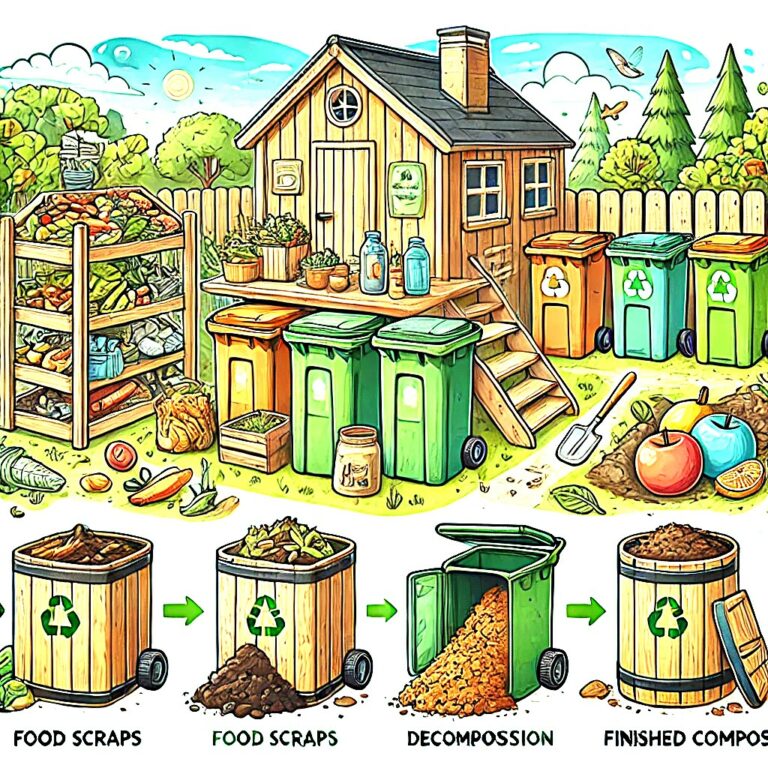Introduction
Composting is an eco-friendly example to recycle organic waste and improve your garden soil. Building your compost bin is a cost-effective solution that helps reduce landfill waste while providing nutrient-rich compost for your plants. This guide will show you how to make a compost bin and offer tips on effective composting.
Benefits of Composting
Composting offers numerous environmental and gardening benefits. It reduces waste, improves soil health, and promotes sustainable gardening practices.
The Waste Reduction
Composting diverts organic waste from landfills, reducing methane emissions and lowering your carbon footprint.
Soil Improvement
Compost enriches soil by adding essential nutrients, improving soil structure, and increasing water retention.
Sustainable Gardening
Using compost decreases the need for chemical fertilizers and supports healthy plant growth, contributing to a more sustainable gardening approach.
Choosing the Right Location
Select a location for your compost bin that is convenient and accessible. Ideally, the spot should be in partial shade to prevent the compost from drying out too fast.
Factors to Consider
- Accessibility: Select an area that is easy to open for adding materials and turning the compost.
- Drainage: Ensure the region has good drainage to prevent waterlogging.
- Ventilation: Proper airflow is essential for effective composting.
Types of Compost Bins
Depending on your space and needs, There are several compost bins to choose from. Each type has its own advantages and setup requirements.
Stationary Bins
These are traditional compost bins that sit directly on the ground. They are simple to build and maintain, making them ideal for more extensive gardens.
Tumbler Bins
Tumbler bins are enclosed containers that can be rotated to mix the compost. They are great for smaller spaces and speed up the composting process.
Worm Bins
Worm bins use red wiggler worms to break down organic matter. They are perfect for indoor composting and producing high-quality vermicompost.
Building a Stationary Compost Bin
A stationary compost bin with basic materials is easy to construct. Follow these steps to build your own.
Materials Needed
- Wooden pallets or planks
- Nails or screws
- Hinges (if adding a lid)
- Wire mesh (optional for ventilation)
Step-by-Step Instructions
- Choose the Size: Decide the size of your compost bin based on your available space and the amount of waste you generate. A 3x3x3 foot bin is a good starting point.
- Build the Frame: Use wooden pallets or planks to create the frame. Secure the corners with nails or screws.
- Add Ventilation: Attach wire mesh to the sides for ventilation if desired.
- Create the Lid: If you want a lid, attach it to the top of the frame using hinges.
- Position the Bin: Place the bin in your chosen location, ensuring it has good drainage and ventilation.
Building a Tumbler Compost Bin
Tumbler compost bins are efficient and easy to use. You can build one with a few basic materials.
Materials Needed
- A large plastic drum or barrel
- Drill and bits
- Metal rods or PVC pipes
- Wooden frame
Step-by-Step Instructions
- Prepare the Drum: Drill several holes around the drum for ventilation.
- Insert the Rods: Insert metal rods or PVC pipes through the drum to act as an axle for rotating.
- Build the Frame: Construct a sturdy wooden frame to hold the drum off the ground.
- Attach the Drum: Place it on the frame, ensuring it can rotate freely.
- Secure the Lid: Ensure the lid is secure but easy to open when adding materials.
Effective Composting Tips
Follow these tips once your compost bin is set up to ensure effective composting.
Balance Green and Brown Materials
Compost requires a balance of green (nitrogen-rich) and brown (carbon-rich) materials. Green materials contain kitchen scraps and grass clippings, while brown materials include leaves and cardboard.
Maintain Moisture Levels
Keep your compost moist but not too wet. A consistency related to a wrung-out sponge is ideal. Water the compost if it becomes too dry and cover it if it gets too wet.
Turn the Compost Regularly
Turning the compost aerates it, speeding up the decomposition activity. Apply a pitchfork or compost aerator to mix the materials every few weeks.
Monitor Temperature
Compost should heat up as it decomposes. A compost thermometer monitors the temperature, ensuring it stays between 110-160°F for optimal decomposition.
Troubleshooting Common Issues
Composting can sometimes present challenges. Here are solutions to common composting problems.
Foul Odors
Bad smells indicate an imbalance or lack of aeration. Add more brown materials and turn the compost more frequently.
Slow Decomposition
If your compost is not breaking down, it may need more moisture or green materials. Adjust the balance and check moisture levels.
Pests
Pests can be attracted to compost bins. Avoid adding meat, dairy, or oily foods. If pests persist, consider adding a lid or using a tumbler bin.
Conclusion
Making a compost bin is a simple and effective manner to recycle organic waste and create nutrient-rich compost for your garden. Tracking these steps and tips, you can build a compost bin that meets your needs and supports sustainable gardening practices. Start composting today and experience the benefits of healthier soil and reduced waste.
- Growing Bonsai: Tips for Miniature Tree Enthusiasts
- Buying Bonsai: Tips for Selecting Your Perfect Tree
- Bonsai Potting: Essential Tips for Tree Care Success
- Bonsai Maintenance: Essential Care for Tiny Trees
- Mastering the Art of Shaping Bonsai: A Beginner’s Guide
Source: How to build a compost bin


